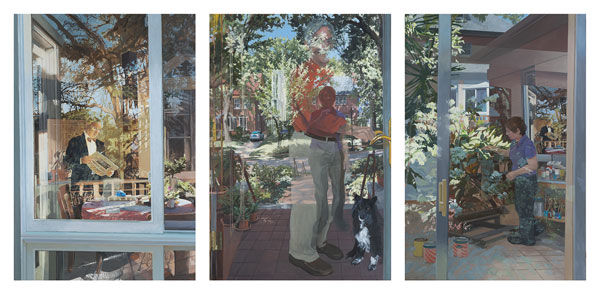Artist’s work encourages viewers to reflect
Published April 20, 2016
Petruta Lipan, director of St. Louis University Museums & Galleries, has high praise for the late St. Louis painter Linda Skrainka.
“Linda Skrainka is a powerful artist. Her power sneaks up on you when you look at her work,” said Lipan, who curated “Reflections,” an exhibition of Skrainka’s work that is on view at the St. Louis University Museum of Art through May 15.
After Skrainka died in 2014, her husband and sister-in-law met with Lipan and put together a retrospective of the artist’s work.
Lipton said, “The family always wanted her to have a big show, but she said no. She was a private person. Her family was very supportive of her and her work.”
Lipan hopes the show educates people about Skrainka’s perspective on life and about art in general.
“Everyone is apprehensive about art,” she said. “If you approach it in the right way, you create a new audience who appreciates it. Art has a strong language that crosses linguistic and cultural barriers.”
Skrainka’s husband, Steve, gave Lipan a list of almost all of his wife’s paintings and told Lipan that she kept a journal. Lipan selected works for the show, then asked Steve to find journal passages that were thematically related to the pieces. Some artwork labels feature excerpts of Skrainka’s ideas about, for example, light.
“I included these to help educate viewers about her thought processes,” Lipan said.
While Skrainka didn’t paint any overt references to Judaism, Lipan believes that no one can be separated from his or her religion and culture.
“Skrainka had quotes by important people in Jewish history in her journal and on her bulletin board,” she said. “People think in a certain way because of their religion and culture.”
Lipan arranged the show thematically and chronologically in order to highlight different styles within Skrainka’s work. Skrainka was originally influenced by Matisse, evident in her early pieces, and later developed her own style.
“In many of her paintings, the viewer is outside looking in or inside looking out, through windows or glass doors,” Lipan said. “You can’t help but wonder what that means. Skrainka didn’t write anything about it. Glass is transparent, but it’s also a barrier between inside and outside.”
This architectural commentary is just one of several themes that connect many paintings in the show.
One superb example of this interconnectedness is Skrainka’s oil-on-canvas triptych “Reflections – What Can Be?” The left panel (titled “What Can Be Known?”) depicts Steve Skrainka standing and reading the newspaper in a breakfast nook with floor-to-ceiling windows. The viewer stands outside the house and looks in. Reflections of trees, sky and bushes in the glass confuse the viewer’s eye. Is Steve inside or is he actually outside?
In the center panel (“What Can Be Woven?”), the artist stands on a porch outside a patio door and is reflected in the glass. The dominant reflection reveals a street scene with houses and trees. Steve stands inside by the door, his hand on the door handle. The viewer is placed outside, literally in Linda Skrainka’s shoes. She and Steve are superimposed on each other, almost woven together.
The right panel (“What Can Be Imagined?”) appears to show Linda Skrainka painting inside her studio. The viewer seems to stand outside watching her through a glass door, but reflections of trees and bushes obscure any clarity. Is Skrainka outside and the viewer inside? In the background stands the same image of Steve reading the paper. Who is truly outside and who is inside?
“These paintings are a tour de force for Skrainka,” Lipan said. “They sum up the whole concept of the show. At first glance, she stays on the surface, just like reflections on glass, but she actually goes behind and beyond the glass to what’s inside.”
Like many visitors, Lipan discovers new things in pieces with which she thought she was familiar.
“Even security personnel at the front desk come into the gallery to look at the work again and again,” she said. “The paintings engage everyone. Skrainka’s pieces encourage viewers to be reflective, which is more necessary now than ever in society.”















